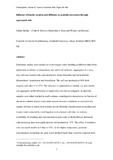JavaScript is disabled for your browser. Some features of this site may not work without it.
| dc.contributor.author | Beulke, Sabine | en_UK |
| dc.contributor.author | Brown, Colin D. | en_UK |
| dc.contributor.author | Fryer, Christopher J. | en_UK |
| dc.contributor.author | van Beinum, Wendy | en_UK |
| dc.date.accessioned | 2005-11-23T13:04:38Z | |
| dc.date.available | 2005-11-23T13:04:38Z | |
| dc.date.issued | 2004-11 | en_UK |
| dc.identifier.citation | Sabine Beulke, Colin D. Brown, Christopher J. Fryer and Wendy van Beinum, Influence of kinetic sorption and diffusion on pesticide movement through aggregated soils, Chemosphere, Volume 57, Issue 6, November 2004, Pages 481-490 | en_UK |
| dc.identifier.issn | 0045-6535 | |
| dc.identifier.uri | http://hdl.handle.net/1826/813 | |
| dc.identifier.uri | http://dx.doi.org/10.1016/j.chemosphere.2004.06.026 | |
| dc.description.abstract | Laboratory studies were carried out to investigate solute leaching at different times from application in relation to temperature and initial soil moisture. Aggregates of a heavy clay soil were treated with a non-interactive solute (bromide) and the herbicides chlorotoluron, isoproturon and triasulfuron. The soil was incubated at 90% field capacity and either 5 or 15oC. The influence of application to initially dry and initially wet aggregates on the behaviour of isoproturon was also investigated. At intervals, samples were either leached in small columns, centrifuged to characterise the fraction of chemical available in pore water under natural moisture conditions or extracted with organic solvents to assess total residues in soil. Bromide concentrations in leachate and in pore water extracted by centrifugation were constant with time. In contrast, availability for leaching and concentration in pore water of the herbicides decreased with increasing time from application in soil incubated at 15oC. The effect of residence time was much smaller at 5 than at 15oC. At the higher temperature, pesticide concentrations in leachate and pore water declined faster than would be expected from degradation alone, probably due to slow diffusion of the pesticides into soil aggregates where they are less available for leaching and/or slow sorption-desorption. The faster decline in availability for leaching at 15 than at 5oC was attributed to faster degradation of the readily available fraction. There was no significant influence of initial soil moisture on either the leaching behaviour of isoproturon or its availability in soil water. | en_UK |
| dc.format.extent | 1946 bytes | |
| dc.format.extent | 143808 bytes | |
| dc.format.extent | 48516 bytes | |
| dc.format.mimetype | text/plain | |
| dc.format.mimetype | application/pdf | |
| dc.format.mimetype | application/pdf | |
| dc.language.iso | en | en_UK |
| dc.publisher | Elsevier | en_UK |
| dc.subject.other | Antecedent moisture | en_UK |
| dc.title | Influence of kinetic sorption and diffusion on pesticide movement through aggregated soils | en_UK |
| dc.type | Article | en_UK |
